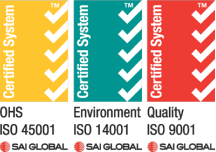a blog by Wagners CFT, National Key Account Manager, Darren Wilson (Connect via LinkedIn)
In the world of Fibre Reinforced Polymer (FRP) structural profiles, two words often get blurred together: manufacturing and fabrication. On the surface they sound similar, but in reality they mean very different things. And when those differences are glossed over, sometimes deliberately, it can create significant risks for engineers, asset owners, and communities relying on FRP structures to perform for decades.
This blog unpacks the difference between manufacturing and fabrication in FRP profiles, why that distinction matters, and how some businesses are confusing the market with claims that can undermine confidence in composites.
What Are FRP Structural Profiles?
Fibre Reinforced Polymer (FRP) profiles are composite materials made by combining a polymer resin with reinforcing fibres such as glass or carbon. Through processes like pultrusion, the fibres are drawn through a resin bath or injection die and cured into strong, lightweight, corrosion-resistant profiles.
The resulting beams, channels, tubes, and panels are used across industries for:
- Utility poles and crossarms
- Pedestrian and vehicle bridges
- Walkways, boardwalks, and platforms
- Industrial infrastructure in corrosive environments
- Marine piles, jetties, and seawalls
FRP is valued because it resists rot, rust, termites, and chemical attack. It offers a 100-year design life with minimal maintenance—far outlasting timber, steel, or concrete in harsh environments.
But for FRP to deliver on that promise, it has to start with quality manufacturing. And that’s where the confusion begins.
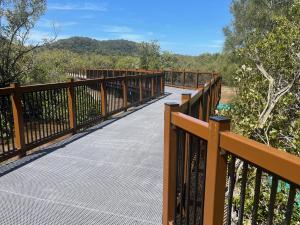
Pictured – a boardwalk constructed from FRP profiles and mesh
Manufacturing: Where Quality Is Born
Manufacturing is the process of making the FRP profiles themselves. It’s where the chemistry, material science, and engineering come together to produce the “raw” components.
Key elements include:
- Material selection: Choosing fibre type (glass, carbon) and resin system (polyester, vinyl ester, epoxy), plus additives for UV resistance or fire performance.
- Pultrusion: The continuous process of coating fibres with resin and curing them in heated dies, producing strong, consistent profiles.
- Quality control: Testing of raw materials, wet out, curing, mechanical properties, and compliance with standards (ASTM, ISO, Australian Standards).
The outcome of manufacturing is standardised FRP profiles including beams, channels, or tubes that form the building blocks of any project. This is where durability and performance are locked in.
If the raw material selection or manufacturing process is poor, the profiles will be poor—no matter what happens later.
Fabrication: Shaping Profiles into Structures
Fabrication, by contrast, is what happens after the profiles have been manufactured. It involves:
- Cutting and machining profiles to project specifications.
- Joining using bolts, adhesives, or proprietary connections.
- Customising assemblies into bridges, platforms, shelters, or towers.
- Pre-assembling modules off-site for efficient installation.
Fabrication is about turning raw FRP into usable structures. It requires engineering skill, project experience, and precision, but it does not change the fundamental quality of the material.
In simple terms:
- Manufacturing makes the FRP.
- Fabrication shapes it for real-world use, cutting, joining and assembling profiles into working infrastructure.
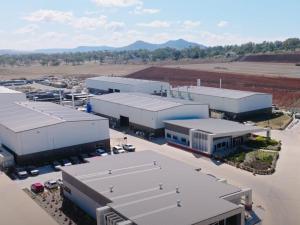
Pictured – Wagners CFT manufacturing facility at Wellcamp in Queensland.
Where the Market Gets Confused
Here’s where things get tricky. Some businesses market their products as “fabricated in Australia” to imply a level of local quality assurance and origin. But in reality, many of these companies are importing FRP profiles manufactured overseas, often to lower standards, and then doing basic cutting or drilling locally.
The result? A product that may technically be “fabricated” in Australia but is fundamentally built on imported, and sometimes inferior, FRP.
Why does this matter?
- Material integrity: If the FRP wasn’t manufactured to recognised standards, it may not have the strength or durability promised.
- Compliance risk: Imported profiles may not meet local codes or testing requirements.
- Lifecycle cost: Inferior materials will fail sooner, leading to costly maintenance or replacement.
- Trust: When marketing blurs the truth, it damages industry credibility and confuses customers.
Fabrication alone cannot upgrade a weak or inconsistent FRP profile. Quality is created in manufacturing—not after.
Why Distinguishing the Two Is Critical
For engineers, asset managers, and procurement teams, recognising the difference between manufacturing and fabrication helps avoid costly mistakes.
- Procurement Clarity
When sourcing FRP, ask: Am I buying raw profiles manufactured in Australia, or am I buying fabricated assembled profiles from unknown or imported origins? - Performance Assurance
Manufacturers deliver tested profiles that meet international standards. Fabricators must then assemble these into structures that comply with project codes. Both are critical, but they are not interchangeable. - Supply Chain Transparency
A genuine Australian-manufactured FRP profile provides assurance about its history of origin, standards, and quality control. Imported, re-branded FRP does not. - Value for Money
Paying a premium for a “locally fabricated” structure built from low-grade imported FRP isn’t value, it’s a liability.
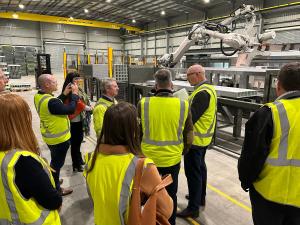
Pictured – Visitors to Wagners CFT Wellcamp manufacturing facility watching the Crossarm Assembly Line (CAL) in operation.
A Simple Analogy
Think about a high-performance sports car. The engine, chassis, and suspension are designed and built to exacting standards; this is manufacturing. Now, a mechanic can assemble the car, customise the interior, or add accessories; this is fabrication.
Now imagine if a company imported a cheap, underpowered engine from overseas, slapped it into a locally fitted chassis, and marketed the car as “assembled in Australia.” No matter how well the interior was customised, the car would never perform like the genuine high-performance model.
The same principle applies to FRP. Fabrication can shape, cut, and join profiles, but the ultimate strength, durability, and compliance of the structure are determined by the quality of the manufactured FRP.
The Future of FRP in Australia
The demand for FRP in infrastructure is only going to grow. Its performance in corrosive, coastal, and industrial environments makes it a smart, sustainable alternative to steel, timber, and concrete.
But for FRP to reach its potential in Australia, the market requires clarity and honesty:
- True manufacturers should be recognised for the science, innovation, and quality they bring.
- Fabricators play a vital role in tailoring those profiles into solutions, but should not mislead customers about origin or quality.
- Customers should demand transparency about where the profiles were manufactured, and to what standards.
When manufacturing and fabrication are both done well and clearly communicated, FRP delivers the long-term performance our infrastructure demands.
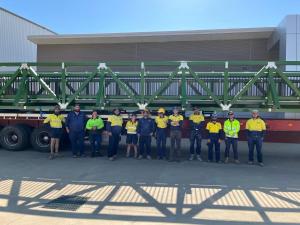
Pictured – Some of Wagners CFT construction and project crew standing in front of the preassembled Scottsville Road, pedestrian bridge ready for delivery to Collinsville in north Queensland.
Conclusion: Don’t Be Misled
At the end of the day, the difference between manufacturing and fabrication is more than semantics. It’s the line between genuine quality and a clever marketing spin.
Some businesses are muddying the waters importing inferior FRP, performing minor modifications locally, and branding it as “fabricated in Australia.” But fabrication cannot fix weak materials. If the profiles were not manufactured to the highest standards, the structure will never achieve its intended performance.
So, here’s the takeaway for engineers, asset managers, and procurement teams:
- Ask the hard questions. Where were the profiles manufactured? To what standards? Who certified them?
- Look beyond the label. “Fabricated in Australia” is not the same as “manufactured in Australia.”
- Protect your projects. Insist on transparency so you can be confident in the FRP you specify and install.
FRP is the future of durable, sustainable infrastructure. But only when the industry is clear and honest about what’s manufactured, what’s fabricated, and why the difference matters.
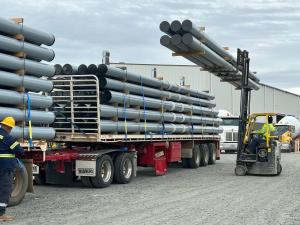
Pictured – Loading B-double with FRP utility poles at Wagners CFT Wellcamp manufacturing facility in Queensland.
Wagners CFT: What We Manufacture and What We Source
At Wagners CFT, all structural FRP profiles are manufactured locally at our Wellcamp facility in Queensland, using a combination of local and carefully selected imported raw ingredients. Our team of around 150 skilled professionals—including pultrusion operators, polymer and injection moulding technicians, engineers, draftspersons, carpenters, mechanical engineers, electricians, and fitter and boiler makers; to ensure that every profile meets our stringent quality standards.
It’s important to note that while we manufacture all our structural profiles on-site at Wellcamp in Queensland, all decking is imported ready-made, produced exactly to Wagners CFT’s specifications to ensure consistency, durability, and compliance. This distinction reflects our commitment to transparency and quality: we manufacture what impacts structural integrity and safety, and source only what can be reliably produced to our exacting standards.
See Wagners CFT Product Guide for more details on the products we offer – https://www.wagnerscft.com.au/app/uploads/2024/05/wagners-cft-product-guide-2021-v05-metric-2022-updated.pdf
To organise a tour of Wagners CFT manufacturing facility in Queensland, Australia complete the Contact Us form on our website https://www.wagnerscft.com.au/contact-us/
Watch a webinar on FRP structural profiles and discover It’s What’s Inside That Counts! – Wagners or read the news article https://www.wagnerscft.com.au/its-whats-inside-that-counts/
Watch the 30-minute webinar on Wagners CFT and how the business produces one of the world’s strongest pultruded FRP products https://www.wagnerscft.com.au/webinars/an-introduction-to-wagners-composite-fibre-technologies-cft/

